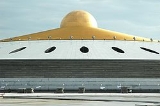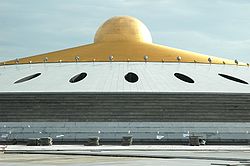
Wat Phra Dhammakaya
Encyclopedia

Wat
A wat is a monastery temple in Cambodia, Thailand, or Laos. The word "wat" means "school".- Introduction :...
) in Khlong Luang District
Amphoe Khlong Luang
Khlong Luang is a district in Pathum Thani Province, central Thailand.-History:Originally, the area was part of the Bang Wai district, controlled by Mueang Thanyaburi. In the Ayutthaya era, this area was lowland deep forest...
, Pathum Thani Province north of Bangkok, Thailand
Thailand
Thailand , officially the Kingdom of Thailand , formerly known as Siam , is a country located at the centre of the Indochina peninsula and Southeast Asia. It is bordered to the north by Burma and Laos, to the east by Laos and Cambodia, to the south by the Gulf of Thailand and Malaysia, and to the...
.
Origins
It was established on Magha Puja Day, 20 February 1970, on an eighty-acre (320,000 m²) plot of land donated by Lady Prayat Phaetayapongsa-visudhathibodi by a group led by the monk PhrarajbhavanavisudhPhrarajbhavanavisudh
Phrarajabhavanavisudh is the abbot of Wat Phra Dhammakaya in Thailand and the president of the Dhammakaya Foundation.-Childhood:He was born Chaibul Sutthipol on the 22 April 1944 to Janyong Sutthipol and Juree Sutthipol At Suan Kularb School, Bangkok, Thailand, Chaibul during his adolescence,...
and his teacher Chandra Khonnokyoong
Chandra Khonnokyoong
Chandra Khonnokyoong was a Thai Theravada Buddhist nun who founded the Wat Phra Dhammakaya organization. Her full title was Khun Yay Mahā Ratana Upāsikā Chandra Khonnokyoong...
. The site, sixteen kilometres north of Don Mueang International Airport, was originally called 'Soon Buddacakk-patipatthamm' . From acidic paddy fields, a woodland was created: a parkland for meditators. The foundation stone for the main chapel laid by H.R.H. Princess Maha Chakri Sirindhorn
Maha Chakri Sirindhorn
Princess Maha Chakri Sirindhorn is the second daughter of King Bhumibol Adulyadej. Thais commonly refer to her as Phra Thep, meaning "princess angel." Because her title in Thai is the female equivalent of the title held by her brother, Crown Prince Maha Vajiralongkorn, she is informally referred...
on behalf of H.M. the King in December 1977 becoming officially recognized as a temple by the Thai government in 1978 originally under the name 'Wat Voranee Dhammakayaram'. The Main Chapel was completed in 1982 and the ceremony for the allocation of the chapel boundary (sima) was held three years later. While the temple was under construction, the Dhammadayada ordination scheme gave training to hundreds of university students, a steadily increasing number of whom swelled the number of residents in the temple community.
Public accusations of 1999–2002
Wat Phra Dhammakaya has experienced its share of controversy. In 1999 and again in 2002 the temple's abbot, was accused of charges ranging from fraud and embezzlement to corruption. Social critic Sulak SivaraksaSulak Sivaraksa
Sulak Sivaraksa [] is founder and director of the Thai NGO “Sathirakoses-Nagapradeepa Foundation”, named after two authorities on Thai culture, Sathirakoses and Nagapradeepa...
criticized the temple's abbot for promoting greed by emphasizing donations to the temple as a way to make merit. Julian Gearing of Asiaweek commented that Widespread negative media coverage at this time was symptomatic of Wat Phra Dhammakaya being made a scapegoat
Scapegoat
Scapegoating is the practice of singling out any party for unmerited negative treatment or blame. Scapegoating may be conducted by individuals against individuals , individuals against groups , groups against individuals , and groups against groups Scapegoating is the practice of singling out any...
for commercial malpractice in the Thai Buddhist temple community in the wake of the 1997 Asian Financial Crisis. Apologies to Wat Phra Dhammakaya were published in full after the Thai newspapers and TV channels concerned were successfully sued for slander in the period 2001-3. In 2006 The Thai National Office for Buddhism cleared Wat Phra Dhammakaya's abbot of all accusations when he agreed to donated all funds to the name of the temple. He was subsequently restored to the position of abbot of Wat Phra Dhammakaya.
Activities to present
The community living at Wat Phra Dhammakaya now numbers 3,000 monks, novices, laymen and laywomen - making it the largest temple in Thailand in terms of inhabitants. Congregations on Sundays and major religious festivals reach 100,000, which since 1985 exceeded temple capacity and influenced the temple's decision to expand the site to one thousand acres (4 km²) with the building of the World Dhammakaya CentreWorld Dhammakaya Centre
The World Dhammakaya Centre is a Buddhist parkland and sanctuary. It is located at Pathum Thani Province, Thailand. It is an extension of the temple called Wat Phra Dhammakaya and is arguably synonymous. This extension was started in 1985 by Phrarajbhavanavisudh and Khun Yay Mahā Ratana Upāsikā...
project. The temple has also organized a World Peace Ethics Contest in which people from all over the world compete in their knowledge of Buddhist ethics. Part of the World Dhammakaya Centre project is to construct a cloister intended to accommodate Buddhist monks from all over the world. Aside from religious activity, the temple has granted financial aid and supply to the numerous schools and temples in Southern Thailand, which presently is in the midst of violent conflict.
Dhammakaya sponsorship of Buddhist studies and research
Wat Phra Dhammakaya has since the 1980s taken an interest in international connections and Buddhist studies beyond its own walls. Its academic wing, the Dhammachai International Research Institute (DIRI), started in1985 (REF: Wat Phra Dhammakaya main website http://www.dhammakaya.net/กิจกรรม/ฟื้นฟูพระพุทธศาสนา/สถาบันธรรมชัย, August 2011). DIRI sponsored its members to study abroad in the 1980s, including Mettanando Bhikkhu at Oxford and Hamburg (Ref: www.congress-on-buddhist-women.org/indexbce2.html?id=115) and Thanavuddho Bhikkhu at Tokyo (http://repository.dl.itc.u-tokyo.ac.jp/dspace/handle/2261/6942). In this and subsequent activities, DIRI has been ahead of other Thai Buddhist organisations in terms of its engagement with Buddhist studies internationally. This international engagement was also an aspect of Wat Paknam, the temple out of which it developed. Wat Paknam was the place where the first Western monks to live in the U.K. – Kapilavaddho (William Purfurst) and his disciples at the English Sangha Trust of London and Manchester – received ordination in the 1950s (Ref: Terry Shine, Honour Thy Fathers, 2002, www.aimwell.org/www.buddhanet.net).Different Thai Sangha groupings are currently seeking links and exchange relationships with Australasian, north American, Asian and European universities as, within the past few years the competition in Thailand for international academic association has increased in the move to provide Buddhist studies degrees for international students, yet Wat Phra Dhammakaya’s engagement precedes this. The Wat organised its first major international academic conference in 1990, attended by some of the most esteemed professors of Theravada Buddhism from around the world, including scholars known to the organisation through the contacts made by its first international students in the UK and Japan. This led to the highly regarded volume of articles, Buddhism into the Year 2000(Ref: Buddhism into the Year 2000, Bangkok and Los Angeles: Dhammakaya Foundation 1994/5). Contributors include several high-ranking scholars, including Prof. Richard Gombrich (Oxford), Prof. Alexis Sanderson (Oxford), Prof. Lambert Schmithausen (Hamburg), the late Prof. Heinz Bechert (Göttingen), Prof Akira Yuyama (Tokyo), and Prof. Ichimura (Berkeley), in addition to several dignitaries: Prof. Ananda Guruge, at the time Sri Lankan Ambassador to UNESCO, and Phra Dr. Kru Vinakorn Virasa Thitthivaro, winner of the United Nations U Thant Peace Award. Thai Princess Vimalachatra was president of the organising committee (Ref: Buddhism into the Year 2000, Bangkok and Los Angeles : Dhammakaaya Foundation, 1994/5).
DIRI has since then expanded its academic sponsorship to include offering studentships for university study around the world to a number of its own followers. It has also developed agreements, exchanges and in some cases substantial sponsorship of research projects and posts at a number of universities throughout Australasia. DIRI’s sponsorship of academic posts and institutions is perhaps best known outside of Asia through its funding of the Lectureship in Buddhist Studies at the University of Sydney in Australia, with funding to the University that by the year 2003 had totaled Australian $1,100,000 (Ref: http://www.usyd.edu.au/news/84.html?newsstoryid=371). At present, DIRI’s own website records that it “has cooperation agreements with Peking University (China) [translation project now complete], Sydney University (Australia), Otago University (New Zealand), Hsuan Chuang University (Taiwan) and Tokyo University (Japan).” (Dhammachai website http://diri-au.org, November 2010). DIRI has sponsored a post and Sydney and developed relations with University of Queensland, Brisbane, Otago, New Zealand, and has sponsored a manuscript digitizing project at Kelaniya University, Sri Lanka (Ref: http://diri-au.org.) Other DIRI academic sponsorship has been organised by the Ven. Thanavuddho (PhD, University of Tokyo), the senior-most academic in Wat Phra Dhammakaya, currently based in Bangkok. His projects include multilingual Tipitaka (canonical) and Atthakatha (commentarial) digitization and translation projects, one based in Bangkok, another in Sri Lanka connected with the newly founded Sri Lankan International Buddhist Academy (SIBA) (Ref:http://www.siba.lk/index.php/siba-dci-research-centre.html). This is headed on the Sri Lankan side by Prof. G. A. Somaratne (Ph.D. northwestern, post-doctoral fellow Oxford and Tokyo), awarded the prestigious Buddhagunupakan - Kancanakiartigun (Highest Decoration of Excellence) by The Standing Committee on Religion, Arts and Culture, The House of Representatives of the Kingdom of Thailand (Ref:http://www.siba.lk/index.php/News/). Within Thailand, the Wat Phra Dhammakaya annually gives scholars to monks and novices pursuing traditional Pali examinations, which are conducted by the Thai Supreme Sangha Council (REF: http://www.dhammakaya.net/กิจกรรม/ฟื้นฟูพระพุทธศาสนา/สถาบันธรรมชัย) and the successful candidates receive their certificates, co-signed by the Minister of Education and the Head of Pali Examination Department (under the Office of National Buddhism) (REF: For a sample picture of these certificates, see http://klongthum.blogspot.com/2011_04_01_archive.html, August 2011).
External links
- Dhammakaya Foundation
- Phra Dhammakaya Temple Controversy Bangkok Post/December 21, 1998

